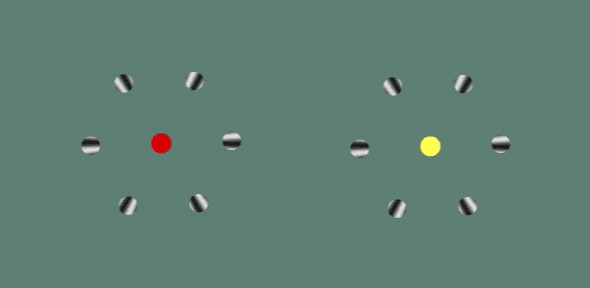Create a free profile to get unlimited access to exclusive videos, sweepstakes, and more!
Another Head-Exploding Illusion: Rotating Rings

I do so love making your brains melt, dear BA Bloggees. That’s why I post the occasional mind-twisting illusion. And I have one here that will tangle your soul into knots.
Below is an animated GIF showing two rings of circles; one with a red dot in the center (left) and one with a yellow dot in the center (right).
Do these things:
Look at the circles around the red dot. Which way do the circles move, clockwise or counterclockwise? (Answer: counterclockwise.)
Now look at the circles around the yellow dot. Are they moving clockwise or counterclockwise? (Answer: also counterclockwise.)
And here’s the part that will destroy you: Look at the circles moving around the red dot. Without moving your eyes (in other words, using your peripheral vision), tell me: Which way are the circles moving around the yellow dot?
Mwuhahahahaha! If you’re like most people, when you look at one ring, the other ring appears to change directions. Look at the red dot, and the circles around it move counterclockwise, while the circles around the yellow dot move clockwise. Look to the yellow dot, and suddenly those circles are moving counterclockwise, and the ones around the red dot are moving clockwise. The way the circles move depends on which circle you’re looking at!
There’s no fakery here. Switch back and forth as quickly or slowly or at whatever pace you want, and every time you do the circles appear to switch directions. It’s maddening.
So what the heck is going on here?
I was initially baffled, but happily I found an explanation. I originally saw this illusion posted on Google Plus by John Baez, though it’s easy to find all over the Web. But in the Google Plus comments, a researcher named Peter Meilstrup stepped in: He’s actually investigated this phenomenon. He posted a paper on how it works (along with several animations of the illusion at work). It’s complicated, and involves a lot of details, but I think I understand it enough to offer up a simple overview.
First, you have to see that there are two motions involved. One is that inside each circle in the outer ring, the pattern of stripes appears to move. It’s difficult to discern, but the pattern appears to be moving clockwise around the central dot. The second motion is of the circles themselves, which appear to move counterclockwise, opposite the motion of the pattern inside the circles.
The difference between the directions of these two motions is critical, because our eyes and brains perceive these motions differently.
According to Meilstrup (in the comments to Baez’s Google Plus post), our brains tend to focus more intently on what’s in the center of our vision. Things near the edge aren’t as important, so the visual data from there gets “compressed,” as he puts it. It’s not just blurring; the way the brain actually interprets that data changes. When something is at the center of your vision, the bulk motion is favored. When it’s near the edge of your vision, the pattern motion gets more attention.
So when you look right at a ring of circles, your brain prefers to notice the bulk motion, and you see the circles moving counterclockwise. The motion of the pattern of stripes looks more like flickering than movement.
But when you look at one ring but pay attention to the other, the clockwise pattern motion of the other ring gets your brain’s attention, not the bulk motion. So suddenly you see the circles moving in the same direction as the pattern: clockwise.
Combining these two motions in different ways yields fun results. Meilstrup has an animation similar to the one above, except in the ring on the right the pattern inside the circles is moving in the same direction as the circles themselves (both counterclockwise). Because of this, the motion of the ring of circles stays moving counterclockwise whether you look directly at it or not. It’s wonderful.
Fiddling with how you look at the rings yields odd results; for example, I sat back from my monitor an extra 30 centimeters and looked directly in between the two dots, right at the center of the animation. The rotating rings both moved counterclockwise, but there was a flicker to them, like the circles were jumping, not rotating smoothly … and sometimes the colored dots disappeared! That last part was because they were falling on the blind spots in one of my eyes or the other. That’s an eerie feeling.
There’s an awful lot to love about this particular illusion. It shows that what we take for granted—what we see faithfully and accurately represents reality—is a load of fertilizer. We are most definitely not seeing the world the way it is! The world is sending out signals (via light, sound, and more) that get filtered through multiple layers of our meat-based sensors; through our eyes, our nerves, our brain. That data gets compacted and reassembled and interpreted and at any and every point it gets changed. What finally looks like “reality” to us may be pretty close to what’s actually going on, but then again, it may not be.
That’s my favorite thing about illusions (besides their sheer delight): They show that what you see is not always what you get.
Trying to figure out what’s real and what’s trying to fool us is why we have science in the first place. In my opinion, that’s actually one of the greatest uses to which we can put it.




























